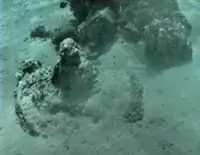Ron Wyatt (1933-1999) was a nurse-anesthetist in a hospital in Madison, Tennessee. His claim of finding 'Wheels from Egyptian Chariots involved in the pursuit of the Israelites from Egypt' has been debunked thoroughly by professional archaeologists and respected biblical scholars. Most professional archaeologists have found so many discrepancies in Wyatt's claims that they do not appear to take him seriously at all.
Several disputes are made against the claim of chariot army at the bottom of the Red sea by Wyatt per 'Holy Relics or Revelation – Recent Astounding Archaeological Claims Evaluated by Standish, Russell R. and Colin D. Standish, 1999'. This book by the Standish Brothers meticulously examines in detail all of Wyatt's claims to serve as a benchmark upon which Ron Wyatt's "discoveries" can be more carefully evaluated.
"First, the site of the Exodus route, as described in Exodus 14:1, is highly disputed. The three specific sites mentioned in Moses’ record “have been lost in the sands of time” (Bruckner, James. 2008. Exodus 129). No one knows the precise place of the crossing. Conservative scholarship strongly argues that Israel crossed the Gulf of Suez (Vow, Howard. 2003. Wycliffe Historical Geography of Bible Lands – Revised), and not the Gulf of Aqaba, as Wyatt contended.'
"Second, Wyatt claimed that he was using simple recreational scuba equipment when he discovered these wheels, etc., at a depth of some 200 feet in the Gulf. However, ordinary scuba apparatus is designed to accommodate only a depth of approximately 125-130 feet. Beyond this, more sophisticated equipment is required."
"Third, Pharaoh’s army was said to have been destroyed “in the middle of the sea” (Exodus 14:23) which, according to measurements of the British Admiralty, is almost 2,800 feet deep in the midst of Aqaba. This hardly harmonizes with Wyatt’s 200 feet “discoveries”!"
"Then there is the issue of the “bones” — of both horses and men — that Wyatt reputedly found. Recall that the destruction of Pharaoh’s army took place about 3,500 years ago. Compare this with the following facts. The Titanic went down in 1912 and 1,553 people were lost in the wreckage. In 1985, 73 years following that Atlantic catastrophe, the submerged vessel was discovered and explored. Specially designed underwater TV and video equipment was employed; in addition, more than 53,000 photos were taken. The remains of not a solitary person — neither skin nor bone — was found. Everything had been completely consumed by fish, crustaceans, and the destructive effect of salt water."
There is no undersea footage of the “gilded wheel” in the film but merely a digital “reconstruction” of a photograph taken by Wyatt in the 1970s. Neither does Wyatt's original photo provide clear evidence as to whether the small piece of coral seen on the wheel simply was placed there or not and no independent peer-reviewed examination by archaeologists and other specialists (to see if they were merely coral formations) was ever conducted and published for the claim of chariot army found at the bottom of the Red sea. "But aside from that, there are the obvious logic problems: If it was a chariot wheel, how would one know it was Egyptian? If Egyptian, how would one know it was related to the Exodus event? And if it was from that event, didn’t anyone notice the incongruity of the sea floor not being littered with these wheels?"
Further detailed claims of Wyatt are critically examined here, here and
here and his profile can be found here.
On August 8, 1996, Joe Zias, Curator of Anthropology/Archaeology with the Israel Antiquities Authority (Jerusalem), issued the following statement:
Mr. Ron Wyatt is neither an archaeologist nor has he ever carried out a legally licensed excavation in Israel or Jerusalem. In order to excavate one must have at least a BA in archaeology which he does not possess despite his claims to the contrary. We are aware of his claims which border on the absurd as they have no scientific basis whatsoever nor have they ever been published in a professional journal. They fall into the category of trash which one finds in tabloids such as the National Enquirer, Sun, etc. It’s amazing that anyone would believe them…

